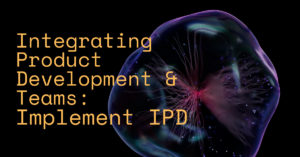
New product development is a sophisticated process requiring the collaboration of numerous teams and disciplines to bring a new product or service to market.
One of the most effective ways to manage this process is through integrated product development (IPD), which brings together all key actors, including engineering, design, manufacturing, and marketing, to work as a united team.
This post will look at IPD ideas, integrated product teams and how they may be used to improve the development process.
Integrated Product Development Overview
IPD is a method that combines all aspects of the product development life cycle, such as design, engineering, and manufacturing, into a single, cohesive plan. IPD aims to improve the development process’s efficiency and effectiveness by reducing the time and costs associated with bringing a new product to market.
This is performed by establishing a product team comprising individuals from all product development disciplines, including engineering, design, manufacturing, and marketing.
Concurrent engineering, which allows different teams to work on other portions of the product simultaneously, is an essential component of IPD. This strategy reduces possible delays caused by changes in one development process element while shortening development timelines.
Project Planning and Scheduling
“Project management” refers to designing and carrying out a project and overseeing the product development process. The project planning phase comprises creating a comprehensive plan that describes the numerous actions that must be completed, the necessary resources, and the overall timeframe of the design process. This phase also includes identifying any hazards or roadblocks that may arise during the project.
Once the project plan is in place, the project schedule may be created. This schedule specifies the tasks that must be completed, the resources required, and the completion date. This timeline then monitors the project’s progress and identifies any potential issues.
The planning stage of a project is a good moment to identify the members of the management team, team leaders, and identify key dates with the development phases.
Project management and execution
During the project’s execution and control phase, the team begins executing the plan. Throughout this phase, team members work together to complete the tasks outlined in the project plan and timeline. This phase also includes tools and procedures, such as project management software, to help track progress and identify potential problems.
Project monitoring and evaluation
Once the project has begun, monitoring and assessing its progress is critical. This phase comprises monitoring the project’s progress, identifying any problems that arise, and making changes as needed to keep the project on track. The team will use gap analysis methodologies to identify disparities between the original design and the present state of the project.
Integrated Product Development Case Study
One example of effective IPD deployment is a case study of automobile component manufacturing. The firm had been experiencing delays and expenditures connected with introducing new items to the market.
They used IPD concepts and reduced development time by 20% and spending by 15%. This was done by establishing a product team of individuals from multiple disciplines and using concurrent engineering to work on different aspects of the product simultaneously.
Engineering project management for integrated product development is a critical tool that may aid in increasing the efficiency and effectiveness of the development process. By bringing together all essential stakeholders, including engineering, design, manufacturing, marketing, and using concurrent engineering, the development process may be sped up and made more cost-effective.
Using project management software and gap analysis tools, the team may also recognize and address any issues that arise during the development cycle. As a result, the finished work will take less time and cost less money.

